The other day on my way home I found myself right in the middle of major bike traffic on N. Williams Ave. I usually go up the Mississippi/Albina Hill, but the heat made Williams much more appealing.
My first sign of bike traffic was at the bike-only signal atop the Eastbank Esplanade at the east end of the Steel Bridge (at intersection with N. Interstate/NE Lloyd). There were about 12 people stopped at that light — enough to make me take my camera out.
Then, as I waited for the light at NE Weidler I had to double take at the line of 12-14 bikes making their way up to Williams. As that group joined me and a few others on N. Williams, I stayed back to take photos.
I’ve heard a lot about the leap-frog with TriMet buses that happens along N. Williams during the evening commute and I knew this would be the perfect time to see it. Sure enough, a bus came along and what happened next was very interesting.
Watch what happens when the people riding bikes realize the bus needs to cross over their lane to get to a stop…
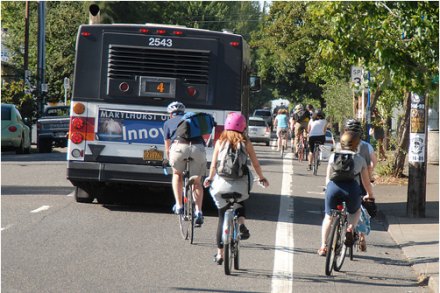
The photo reminds me of a shark swooping in on a school of fish. Notice how they all scatter for survival. It’s interesting to see the different choices each one makes. One guy doesn’t feel like stopping at all and he swoops around to the left to keep going. Another person heads straight for the sidewalk to maintain their momentum. Others decide to just stop and wait behind the bus. (*Note that TriMet GM Fred Hansen recently told BikePortland that bus operators are now trained to not signal at all prior to servicing a stop, precisely to avoid confusion like that seen in the photo above).
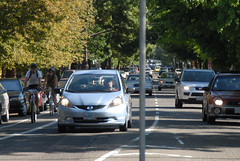
room bikes have to operate (can
you even spot the bikes in the photo?).
Further up the road it becomes clear that as bike use has soared on N. Williams, the roadway space allocated for bicycle traffic is not adequate. A four foot bike lane is sandwiched in between two other lanes of fast-moving motor vehicle traffic and a lane for on-street parking (*update: on many blocks there is on-street parking on both sides). This is far from the “world-class” bikeway experience the Bureau of Transportation is striving for.
In 2008, the Bureau of Transportation counted 2,750 bike trips at the intersection of N. Williams and N. Russell. That’s a 30% increase over the year before (similar to a 28% increase in bike trips citywide between ’07 and ’08).
By contrast, motor vehicle traffic counts on Williams have remained relatively flat. A count at Williams and Alberta in 1996 showed 6,264 car trips. In May 2004, that number had dropped to 5,950 (and then it spiked for some reason in October 2004 to 6,723).
These counts (and these photos) show that bicycles make up a significant portion of traffic on N. Williams. As dense residential units and bicycle-oriented development continues on N. Williams, bike traffic will increase along with it. If my math is correct, given current trends, bikes could soon make up half the trips in this corridor.
It seems like PBOT might want to consider putting N. Williams on a diet. It could stand to lose a few feet of car space. How about taking it down to just one motor vehicle lane, one bike/bus shared lane, and then the on-street parking lane?
Do you ride on Williams during the evening rush hour? What is your experience? Surely there is something that can be done to improve bike/bus/car traffic flow. What are your ideas?

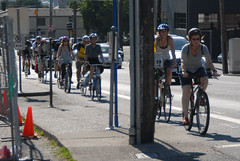
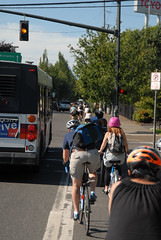
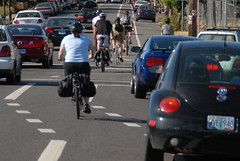
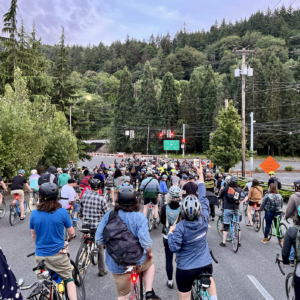
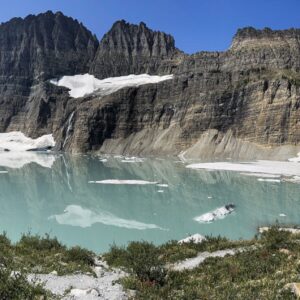
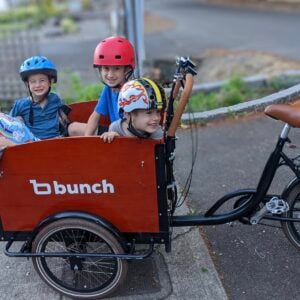
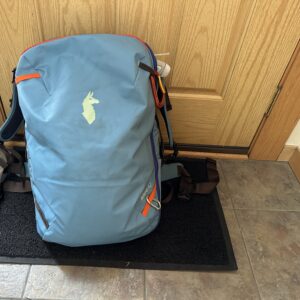
Thanks for reading.
BikePortland has served this community with independent community journalism since 2005. We rely on subscriptions from readers like you to survive. Your financial support is vital in keeping this valuable resource alive and well.
Please subscribe today to strengthen and expand our work.
Well, it’s one-way, so here’s an idea:
Take out the on-street parking on the left side and then move the bike lane to the left side of the street, widening it with the newly reclaimed parking lane. Now you have an ultra-wide bike lane without the threat of dooring on the opposite side of the street from bus traffic, preventing any of this leapfrogging that always occurs.
Other than the opposition to the removal of a parking lane, is there any reason why this wouldn’t work? I often prefer left-hand bike lanes on way way streets for some reason. Maybe it’s the fact that drivers can more accurately judge how much room with which they can pass.
Any other suggestions?
I’ve been cycling on Williams since before bike lanes and agree with your idea: a bus/bike lane and one motor vehicle lane. (Lately, I’ve watched for buses and tried to either slow down or “breakaway” to avoid having the “swoop” cut me off).
They should move the bus stops to the left side of the street. How easy would that be?
It’s funny you bring this up – just in the last few days I’ve been observing that the scramble signal at the top of the Esplanade regularly has more bikes waiting than there are cars waiting at either of the other two legs of the intersection have. Maybe it’s time we gave a scramble signal green after each other auto movement, no?
And I also, as an especially slow bicyclists, dislike being in the bike lanes on Williams. I’m constantly being passed on both sides by bicyclists which is pretty uncomfortable. I especially hate being passed on the right but it’s hard to blame bicyclists as there are often very few cars parked in the right-side parking spots. Maybe we could lose the parking on one side of the street and get a double-wide bike lane?
I also think it’s timely you brought this up. I rode N. Williams in evening rush hour last night, as it is not our normal commute thoroughfare. I was uncomfortable with all the bicyclists, buses, and drivers on the road. Especially as I am commuting more with my daughters on their own bikes, we are a very slow group. Yesterday, riding slow and solo, I was passed twice by bicyclists on the right without warning, and that was a bit frightening. I do see the perceived need to pass on the right when there is much obstacle to passing on the left, but I already ride as far right as I can, so I also think passing on the right is dangerous.
I am going to avoid riding N. Williams for now, as I don’t think it is safe for me and my brood.
here’s an idea…everyone slow the &*^& down and pass buses and other riders on the left when its safe and quit advocating for infrastructure needs to accomodate bad riding styles and choices…unless y’all would like to get out your check book and pay for such things.
I ride the Williams route in the evening, and on days when its too crowded (agree w/ being uncomfortable with that much passing) I’ll often pop over to Rodney 1 block east. More stop signs, less passing, no bus leapfrog. Another nice alternative is Holladay to 7th.
Some thoughtful development on Williams could easily make it into a “world class bikeway experience”, which would be great!
I’ve been riding home on N.Williams for a year and half now. It can get very crowded during the summer and I agree with Johns solution or Blairs (moving the stops makes sense)
Often as the lights turn green to cross Weilder and Broadway there is mad scramble to get up to the front of the line. As further up the road where there are more cars passing becomes more difficult. I often find myself just by passing Williams on busy days now and going up to 7th to avoid the big mob of riders all trying to pass at the same time. So I think a wider bike land could certainly help. I am often guilty of riding fast just to stay away from the groups of riders who might be going slower than I am.
bahueh,
I find it interesting that your comment, advocating for a “take the lane” style of riding, comes just after two women that are several months pregnant.
They are not about to try to mix with traffic in this situation. End of story. It is riders like them that necessitate bikeways that are safe and comfortable and provide a level of separation and breathing room away from motor vehicles.
I use Williams all the time as it is the most efficient street to get to/from any point south of my house. Boy, oh boy has it gotten congested over the last couple of years as more businesses have opened on Williams and more people are commuting by bike. Two obeservations…
1. The bus situation needs to change because the bus drivers I’ve encountered, either on my bike or while driving a car, are super aggresive and somebody is going to get hurt.
2. It would be great if there were a wider bike lane so faster cyclists didn’t have to take the road to pass the slower cyclists. Passing slower cyclists during rush hour can really suck.
the problem is the existence of a striped bike lane at all, coupled with the incessant “ride to the right” mantra. a lot of people heading north on Williams are going to be making right turns along the way — many at Tillamook, just a couple of blocks up, so stashing them in a striped lane to the far left is not a solution.
as for the photo showing scattered responses to a bus coming across the lane to the stop: the correct answer is (a) pass on the left, though “swoop” would not be necessary if the cyclist was asserting the lane, as the bus would not have overtaken in the first instance.
Welcome to my world. Things will be ok again when the rains come 😉
These days I either avoid it altogether (7th or 9th) or take the right lane and throw the hammar down.
Seriously, I agree that removing parking from either side of the street would go a long way towards creating more room and help with the “dooring” threat. It is time.
Moving bus stops to the left wouldn’t work because the access doors are on the right side.
Didn’t I recently read on this site that Tri-Met bus drivers have been instructed not to signal a pull-over if there are cyclists next to or behind the bus to avoid confusion such as that pictured above? Aren’t they just supposed to slow or stop until the bike lane is clear, then signal and move through?
re Jonathan’s comment that came up as I was writing mine. absent a striped lane, and absent on-street parking on the right side, there would be no reason why a slower cyclist could not comfortably ride in the right third or so of the traffic lane. part of what both comments 4 and 5 complain of is cyclists passing on the right, for which there really is no excuse.
RE: bus signaling comment from twistyaction #12..
yes, you did read that here. however, I think even if a bus didn’t signal, just having it slow down would make most people on bikes assume it was about to move over into their lane.
They should move the bus stops to the left side of the street. How easy would that be
You would need a dedicated Williams Ave bus fleet, with doors on the left-hand side of the vehicle. And therefore you would have to change ALL the stop locations on lines 4 and 44. (asking riders to queue in the travel lane while boarding the bus is not an option) At ~$250K a pop for a bus, it’s likely in the 10 million + range. Re-striping the bike lane would probably be a little bit cheaper.
@Blair
Bus stops have to be on the right because of where the door is.
I like John Russell’s idea. Bike lane on the left and let the busses and cars duke it out. The biggest problem with this however, is the on-ramp to 84 or whatever that highway I never go on is called.
One frustration with leap-bus-frog no one has mentioned is that many of the drivers fail to pull all the way over into the bus zone and completely straddle the bike lane (and sometimes half the car lane). It makes it much more tenuous to pass on the left, but I still do. Other drivers do seem to make a concerted effort to pull all the way into the bus zone.
Jonathan, did you notice the road patching going on at N Williams and NE Morris? The construction crew filled in the ditch well enough across the traffic lanes but did not across the bike lane, making it a pretty deep ridge. To the crew’s credit, there is a “bikes in roadway” sign 1/2 block before, but when I’ve signaled to take the lane, many cars have not yielded and have forced me to take the hit of the ditch.
I would like to third the nomination for taking out the parking on the LEFT side of the street and making that a buffered bike lane. There would be no bus-leap-frog this way. It also eliminates all the crossover and jamup with cars at the intersection of N Williams and Fremont. The only dangers would be the cars that dart across the road from the left after coming off the Fremont bridge at N Cook and N Fargo to go north on Williams to get to eastbound Fremont.
RE: cyclists assuming despite Tri-Met’s stated policy comment from Jonathan #14
It seems like Tri-Met has done their part with their drivers by instituting a sensible policy regarding crossing the bike lane. Whether or not the drivers follow this policy is another matter. However, it seems like cyclists have a responsibility to know the “rules of the road” and act accordingly. I certainly think all cyclists in a bike lane should assert their right to the lane (within reason) before darting out of it to the left and right. Tri-Met has made an effort to behave predictably and with respect for our mode of transport, we should be able to do the same.
Only sorta related, but getting onto Williams from Broadway/Weidler is hairy these days when it’s crowded. The bike lane on Broadway from Benton to Williams is so crowded and narrow, that I feel completely squeezed in and claustrophobic when it’s hot out with exhaust in my face. The other day I was in bike traffic along there and we were going so slowly that it actually made it more difficult for me to pedal up the hill.
It is also very sketchy when you take the “left turn” diverter to get onto Williams- which puts you right up behind the intersection. It’s fine when no one else is there, but when there are 2 handfuls of people there before you, you have to ride the wrong way in the vehicle traffic lane on Williams to u-turn and get behind them (or else, just sorta get along side them in the vehicle lane and let the jockeying as you cross Broadway and Williams sort it out).
I randomly took Winning Way for those few blocks the other day, which was quiet and practically empty, and I avoided the crowd and the weird left turn scenario, but there definitely ahs to be a better way 🙂
The worst door zone, in my experience, has been in front of the convenience store on Williams and Fremont. There’s always someone hopping out to run into the store, or pulling out of a parking spot to try and beat traffic whose signal just turned green at Fremont.
As an occasional rider of this route and occasional driver of it as well, I agree for the need for change. There are a ton of bikes as there should be, this is basically a bike expressway.
I think the left-side bike lane should be given a decent amount of credit, this could solve a number of problems. It could take the entire current left traffic lane. There is alot of left-turning cars that will now be turning left from the other (right) lane. What is the typical setup for this? This is especially prevalent at Cook and Fremont. I’m excited for improvements to this area
NE Rodney is not a bad alternative if you feel like cruising a little more slowly and not feeling rushed.
You can pick it up at NE Hancock and it continues all the way to Ainsworth and beyond. I usually jump on a Tillamook. Crossing at Alberta and Killingsworth can be a pain depending on auto traffic.
Of course, that’s not a solution to the larger capacity issues on N Williams bike lane…
Jonathan, regarding traffic on Williams and the 2004 numbers: it looks like traffic on Williams has increased about 8% between 1996 and 2006. The 2004 numbers are anomalous and easily explained – at the time of the traffic counts in 2004, the Broadway bridge was closed, removing a major source of additional traffic on Williams.
I think John Russell has the right idea here. That was my first thought as well.
Vancouver/Williams is a proposed streetcar corridor. If it ever happens, it would be possible (or essential) to have the stops on the opposite side of the street from the bike lane.
I sometimes take the bus up Williams and just this summer noticed the incredible number of bikes on that road. From the bus it is impossible to see exactly what happens between bikes and bus but it looks like an amazing ballet.
I rarely ride on Williams but I’ve encountered some of its problems elsewhere. I’ve played Trimet leapfrog on N Willis, but there are hardly any cars there to deal with. And I’ve been passed on the right on SW Broadway. That’s another tough situation; the bike lane is narrow, and I ride to the left to avoid the door zone, and lots of riders are faster than me and would rather risk doors than cars. Can’t blame them really.
I thought I saw you out there the other day Jonathon :). As a year round bike commuter on Williams / Vancouver this congestion is mostly filled with fair-weather bikers who abandon their bikes when the rain and winter months approach. My favorite day is Monday when all of the PIR / CX guys are heading up usually because they are travelling at the same speed as I am. I’ve had some great sprints with some of them up Williams. Of course they make me pull most of the way! 😛
don’t forget that it’s not just the wind and rain that make people stop riding in the winter… I think it’s also the dark and wet conditions that make unsafe bikeways feel even less safe to novice riders.
If we had a truly world-class bikeway system, we’d see much less winter rider attrition.
I don’t ride up Williams anymore because it is a death trap.
I take the slightly longer, but much less stressful, NE 8th Ave and just cruise all the way home.
Can we get a version of the SE Harrison/Lincoln Bike Boulevard please?
If I am passing another cyclist on Williams I look over my shoulder, wait for a gap in the traffic, then move into the traffic lane to pass. If traffic is heavy and I cannot do that, and there is space on the right, I will pass cyclists on the right. I was unaware that some cyclist feel uncomfortable being passed on the right. I am curious to hear from someone who can explain to me what that is about?
I feel very fortunate to be able to ride Vancouver and Williams every day for my commute. I have been riding it regularly for 3 1/2 years and I cannot recall any run-ins with cars or buses. It is a busy road for both bikes and cars because it is a quick and direct route north, especially when I-5 is jammed at rush hour.
While there are certainly lots of bikes, there are far more cars. It is my opinion that to limit car traffic to one lane would be a traffic nightmare during rush hour.
I appreciate hearing from those that find riding on Williams to be not to their liking so they take a side street. It would seem this would be a far simpler solution than reconfiguring a street to accommodate peak bike trips during the summer months. There are days during the winter when I ride home in the dark and the rain when I see no bikes on Williams at all but there are the same amount of cars.
Wait a second.
TriMet’s bus policy is to now NOT signal when the buses are pulling over to stop??
Since when do buses get to be exempt from the rules of the road?
Personally, pulling over without signaling is a pet peeve of mine. I’m not psychic, you know. Those turn signals are there for a reason: to let the rest of us know what the driver is going to do next!! Same reason motor vehicles have brake lights.
Anyway. Maybe that’s just me. 🙂
Several people have mentioned and/or advocated using NE Rodney (or other alternate to the west) as a solution.
I think it’s unacceptable to ask people who live west of Williams to go even further east, out of their way, just to be able to feel safe and comfortable on their way home.
Many people are on Williams because Greeley, Interstate and the Mississippi Hill are not viable options (they are either too dangerous, too steep, or both).
I think Michigan is a great option to the west, but not many people even know it’s there.
Jonathon @ 29.
I don’t think there is much we can do about changing winter daylight hours, the frigid cold or the rain.
baheuh #6, did you ever think that the infrastructure plays a role in some of these bad riding styles? When this lane was originally set up what was the forecasted load of total traffic volume for bikes? 5%? 10%? Now we’re seeing stretches where 1/3rd of all traffic on this road are bicycles.
It seems pretty clear that bike traffic has exponentially exceeded the load projections for this lane. When that happens, revising the infrastructure is exactly what transportation planners are supposed to do.
With all the talk of alternate routes like Rodney and 7th, 8th, and 9th, I just checked the Bicycle Master Plan proposed updates for this area:
http://www.portlandonline.com/transportation/index.cfm?c=44672
It looks like no changes are proposed for Vancouver/Williams but that bike boulevards are proposed for both Commercial/Haight to the west and Rodney/Mallory to the east. I imagine both of those would take some of the heat off Williams especially as they became better known, especially to cyclists who prefer quieter & slightly slower to bicycle expressways.
They are releasing the draft incorporating public comment from the open houses late this summer, for “public comment.” Would this be a good time to bring up the issue of improving Williams too?
Jonathan, I agree with you about options for North Portland riders!! I want to add to my last comment that even with the potential Commercial/Haight improvement, west-bound riders would still be forced to take Williams from Weidler to Fremont. which as we know, is where some (if not most) of the most dangerous congestion is.
Esther,
thanks for linking to the Bike Master Plan. Tomorrow I will begin a multi-part series that looks at what’s in the plan and hopefully gets people interested enough to get involved and comment when the time comes.
now…as for Williams. Our City Bike Coordinator Roger Geller has said publicly that “our infrastructure has not kept up with bike use”. This is a clear situation where that applies.
1.Widen the sidewalk cutout at the scramble signal so southbound bike traffic doesn’t have to veer into the lane to get onto the sidewalk to descend the hill, and nearly collide with waiting northbound bike traffic on the sidewalk.
2. Start heavy enforcement against the freeway bound cars that crowd into the intersection @ I-5 south onramp/N. Williams blocking the bike lane after their light has turned.
3. Re-time the signal at Wheeler/Williams/Winning so getting across Weidler & Broadway on the same cycle doesn’t require a full sprint.
4. Fix that confounded pit in the bike lane referred to by John (18). I don’t care if they ran out of asphalt, (not my problem) the contractors have created a road hazard and it’s been nearly a month now.
5. I have had a building feeling for sometime now that this street should be reduced to a single vehicle lane. But I would be equally comfortable with sharing a transit lane with buses, or having a dedicated bike lane on the left.
6. Reducing auto traffic to one lane would negate my final gripe which is that traffic (hazard) island at Graham street which narrows the lanes.
@Kt #33: You mis-understand the recent change in policy. The drivers (as far as I know) have been instructed only to signal when the bike lane they must cross has cleared of riders. If there are riders in the bike lane that would be affected by the bus’ crossing to the curb, the bus should slow to let the cyclists pass before signaling, then moving to the curb. The decision to not signal their intent to cross the bike lane if riders are in it stems from Tri-Met recognizing the cyclist’s right not to be cut off. I like that. I think we, in turn, should act predictably and not scatter all over the place when we see a bus slowing (for us) in order to pull over for a bus stop.
I hope this is clear now. Tri-Met is still using all their signals, all the time (or are supposed to be). They have just given cyclists the courtesy and respect of not presuming that once the bus’ right turn signal is on, the bus driver will expect bike lane traffic to yield. That’s the scenario for buses moving right across the bike lane. The law remains that when a bus is leaving the curb and the little yield sign on the left-rear of the bus lights up, all vehicle traffic which would have overtaken the stopped bus must yield for it to re-join traffic.
Rodney is OK until you get to Fremont, then you have to wait for the traffic to clear, which is usually quite busy at rush hour, because Rodney doesn’t go straight through there — it jogs east 100 or so feet. Fix Williams.
if the striped lane were not there, and cyclists were encouraged (rather than in effect forbidden) to assert the right travel lane, and if everyone understood that passing is done on the left (like in the, y’know, real world) there would be no need for a bus driver to wait for anything to “clear.”
re comment 32. I don’t care where you pass me, but the social norm is to pass on the left. that is where my mirror is, and that is where I am expecting to see you. if you attempt to pass on the right, you are taking the risk that I might fade right (whereas people do not generally fade left in traffic).
As Oliver #40 says, I get in the lane and sprint up to Broadway just to catch the light there and at Weidler. Then I sprint another block until I can get into a break in the bike lane jam. It’s kind of fun and I hope I’m not being rude. The traffic thins out enough then that I can wait my turn and take the lane if I need to pass somebody. I’ll make do with existing infrastructure. Although a bike lane on the left in place of parking sounds interesting. It doesn’t seem there are many store fronts relying on parking on the left side of the street. Dawson Park, residential, empty lots… Maybe angle parking on the right could make up a few of the lost spaces. Or does angle parking not work with busses?
As someone who uses williams occasionally for many of the reasons stated above, I have several suggestions:
Re: Taking the lane. I do this a lot. A lot of the drivers on Williams do respect bikes in the road, but a significant minority believe that bikes have NO PLACE in the traffic lane and they will buzz you close and get all pissed off. Not really a nice way to get home at night, and I’d rather not deal with road ragers.
Re: slowing down; No. You speed up.
Re: No bike lane at all. Then most people would find another way to get to work or home, like drive. Most cyclists are total pussies about taking the lane. This has to do with the fact that getting buzzed by some toothless idiot in a clapped out jalopy with washington plates is scary, especially since your family won’t get any money for suing them once they run you over.
I like the idea of the left lane wide bike lane: this would remove a lot of the conflict with the bus, and would give people space to pass the slows without risking their neck in occasionally hostile traffic. Of course, the businesses won’t have it, since they need parking for both their customers.
I travel the Williams/Vancouver corridor between Ainsworth and the Esplanade on a regular basis – 3-4 times a week RT.
I have to say that on my own priority list, I don’t view the Williams corridor as one in need of bike infrastructure improvement or funding.
I can appreciate what some folks have expressed and what Jon documented, but I have to say that I haven’t had any real issue with cars or buses on Williams. I have never had leap frogging with a bus last more than a stop – two at the most.
I am not some risk taker or super biker, I am an experienced cyclist and here is what I typically experience heading North on Williams during the PM peak:
Once you are off the esplanade/steel bridge, you may see a bunch of bikes at the light at Weidler (mostly because folks are coming off the Broadway Bridge)
I believe this temporary pack has more to do with the nature of the lights at that location than anything else. Same thing happens to cars during peak at certain locations – they bunch at the lights.
However, the bike pack dissipates pretty quickly once you are heading up the hill.
You won’t see a dozen bikes waiting at Russell or Fremont or any other light North of Broadway (or at least, I have never seen this).
As you can imagine, a lot of passing happens between Broadway and Fremont as the pack stretches out heading North up the hill on Williams. And here is where I think there may be a safety concern with traffic on the corridor.
Namely, during this thinning of the pack you won’t hear much voice or bell usage during passing. It gets mentioned here a lot but really bikers don’t really see each other unless they hear each other first.
More striking, in my personal opinion, is that there are folks who are strong riders that are unwilling to take the auto lane to pass other cyclists – even when it is completely clear.
Instead these folks squeeze by other bikers in the bike lane itself or on the lane’s striping (i.e. within the dynamic envelope of the biker being passed).
Now, I know there is some ODOT thing about needing to use the bike lane and blah, blah, blah but I don’t think that is what is happening here.
Honestly, I think there are riders out there who are not used to riding WITH auto traffic; i.e. they are most comfortable traveling in a bike lane or other designated/dedicated bike area and may not realize the risk they are taking by trying to stay their “safe zone” or as close as possible to it.
Now, I realize that situation I am outlining could be viewed as evidence for why the bike lane should be wider but I don’t see it that way.
The auto lane is available, or will be if you hold back for what is always less than a minute – even during peak traffic, really. So I think the capacity is already there; however, the experience and education may not be.
So yes, there is a bit of a problem here but I think there is a soft fix to this – namely, education and experience.
why does the left lane bike lane have to replace parking? there should be enough space to have a bike lane then parking then cars then parking like so:
peds | bikes | park | cars | park | peds
this would replace the current setup of:
peds | park | cars | cars |b| park| peds
don’t you think this would be glorious? where there isn’t currently parking, the bikes and cars would be next to each other.
I find it interesting that your comment, advocating for a “take the lane” style of riding, comes just after two women that are several months pregnant.
They are not about to try to mix with traffic in this situation. End of story. It is riders like them that necessitate bikeways that are safe and comfortable and provide a level of separation and breathing room away from motor vehicles.
Jonathon, while bahueh’s suggestion that increased/improved infrastructure is worthless is a bit extreme, your demand for the illusory safety of separate infrastructure is itself a bit short sighted. It’s impossible to deny that riding *sensibly* and *predictably* factors into things. You could put in two-stage bike signal and a six-foot wide lane that turns into a ramp that takes cyclists up and over the bus stop and then back into a safe position, with a timed sensor that gives the bus an all-clear. It’s not going to do jack in the way of preventing people who ride too close/too fast for conditions/without signaling/etc. from confusing the hell out of everyone else and putting themselves (and likely others at risk) -pregnant women or otherwise! Put in all the cycletracks, bike lanes, and so on that you want – the person weaving around the bus without signaling or shooting onto the sidewalk and back will still screw things up.
Infrastructure needs increase when demand increases, and this stretch of Williams has got it in spades. Assuming that the increase is thoughtfully engineered and carefully planned, it still needs to be used properly. There’s no either/or about it.
As a frequent user of this route from the Esplanade to Ainsworth, I’d like to compile a “Greatest Hits” of suggestions:
From Oliver:
1.Widen the sidewalk cutout at the scramble signal so southbound bike traffic doesn’t have to veer into the lane to get onto the sidewalk to descend the hill, and nearly collide with waiting northbound bike traffic on the sidewalk.
Poorly planned in the first place…
“Let’s put the scramble sensor right in the middle of the road.”
2. Start heavy enforcement against the freeway bound cars that crowd into the intersection @ I-5 south onramp/N. Williams blocking the bike lane after their light has turned.
Perhaps a stoplight camera???
3. Re-time the signal at Wheeler/Williams/Winning so getting across Weidler & Broadway on the same cycle doesn’t require a full sprint.
Seriously…this would take how long to correct? Am I pushing my luck to ask for Russell, too? Maybe for those of us that can maintain a good pace (15+) through that stretch.
4. Fix that confounded pit in the bike lane referred to by John (18). I don’t care if they ran out of asphalt, (not my problem) the contractors have created a road hazard and it’s been nearly a month now.
I’m surprised I haven’t flatted yet.
Thanks Jessica…
just in the last few days I’ve been observing that the scramble signal at the top of the Esplanade regularly has more bikes waiting than there are cars waiting at either of the other two legs of the intersection have. Maybe it’s time we gave a scramble signal green after each other auto movement, no
Again, a really easy fix.
Thanks Esther…
I just checked the Bicycle Master Plan proposed updates for this area:
http://www.portlandonline.com/transportation/index.cfm?c=44672
It looks like no changes are proposed for Vancouver/Williams but that bike boulevards are proposed for both Commercial/Haight to the west and Rodney/Mallory to the east.
The traffic from Weidler to Fremont would be much more difficult, however. My suggestions…
1. bike boxes across BOTH lanes of through traffic at Weidler/Williams that funnel bike traffic to the entire right-hand lane of Williams before Broadway. If the lights are re-timed as per Oliver’s suggestion, this would work splendidly.
2. A shared bike/bus lane on the right. Most frequent users of this route would learn quickly just to stay near the left side of the right lane (near the center of the road, I guess) to avoid the leapfrogging of buses. Plus, North of Russell, remove parking from the left side of the road and add a left turn lane for the hospital streets (Knott, Graham, and Stanton). AFTER removing that dump-4$$ traffic hazard island at Graham.
3. By the time we get to, say Monroe or Fargo, we could be down to a normal bike lane because the faster riders would be ahead and the slower behind. This would also help out all of those drivers that are still amped up from the madness that is the East end of the Fremont Brige at rush-hour. But PAINT THE BIKE LANE AT FREMONT!!!
Thanks for your time,
Ray
As a regular Williams/Vancouver biker I LOVE the route as it is one of the fastest ways to get anywhere on a bike!! Yes, the bus leapfrog can get annoying,but if you’re a bike that has a drivers licence it is pretty easy to negotiate because you know the rules of the road. Is the bus stopping and I’m close behind? signal and go around to the left if safe or just wait. Is the yeild flasher on? Yield. Uncomfortable passing the bus – wait. Yes, there is a ton of traffic, but due to the sparse placement of traffic signals the bike traffic spreads out pretty quick. In some ways I feel safer when there is the congested bike traffic as I feel the cars MUST be aware of all the bikes because they are literally everywhere… As a faster, more experienced rider when I need to pass I’ll shoulder check and take the lane when it is safe to do so. On super hot days, or days where I’m not into people I’ll duck into the neighborhoods and cruise, perfectly viable option and still very direct and quick.
Well said, jered. Though for what it’s worth, it’s not necessary to be *licensed* to know the rules of the road. Leastways, if you’re a cyclist. The bike itself may have some issues. 😉